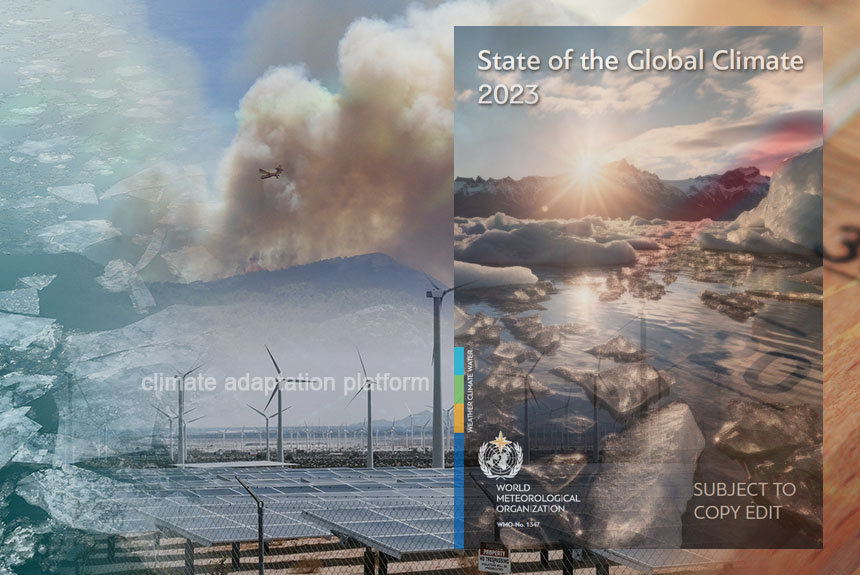The World Meteorological Organization’s State of the Global Climate 2023 report, released on 19 March 2024, confirmed that 2023 was the hottest year on record and that every single climate indicator was once again broken for greenhouse gas levels, surface temperatures, ocean heat and acidification, sea level rise, Antarctic sea ice cover and glacier retreat.
Extreme events, such as floods, heatwaves, wildfires, droughts, and strong cyclones, have upended the lives of millions and cost the economy billions of dollars.
The World Meteorological Organization (WMO) says that the report gave ominous new significance to the phrase “off the charts.”
Key Takeaways from the report:
Land and ocean temperatures
The global average near-surface temperature in 2023 reached 1.45 °Celsius (with a margin of uncertainty of ± 0.12 °C) above the pre-industrial 1850–1900 average. 2023 is also the warmest 174-year observational record. The temperature is inching toward the 1.5° C limit set by the Paris Agreement, which is why the WMO community is sounding the “red alert to the world”.
Nearly one-third of the global ocean was gripped by a marine heatwave, harming vital ecosystems and food systems.
By the end of 2023, over 90% of the ocean (the global ocean between 20° S and 20° N) had experienced heatwave conditions. We also saw a broad band of severe and extreme marine heat waves across the North Atlantic, with 3 °C above average temperatures. The Mediterranean Sea also experienced near complete coverage of strong and severe marine heat waves for the twelfth consecutive year.
Ocean warming increases have been strong in the past two decades and are expected to continue. They will become irreversible if they continue for hundreds to thousands of years.
Sea level rise, sea ice loss and glacier retreat
Antarctic sea ice extent was by far the lowest on record, with the maximum extent at the end of winter at 1 million km2 below the previous record year – equivalent to the size of France and Germany combined.
Global sea level reached a record high in 2023, reflecting thermal expansion from the continued ocean warming and glacier and ice sheet melting.
Socio-economic impacts
The number of acutely food-insecure people worldwide has more than doubled, from 149 million before the COVID-19 pandemic to 333 million people in 2023 (in 78 countries monitored by the World Food Programme). Although climate extremes may not be the root cause, they are aggravating factors, according to the report.
Weather hazards continued to trigger displacement in 2023, showing how climate shocks undermine resilience and create new protection risks among the most vulnerable populations.
GHG emissions
Emissions of the three main GHGs—carbon dioxide, methane, and nitrous oxide—reached a new record in 2022 and showed a continuing trend in some locations in 2023. CO2 levels are 50% higher than in the pre-industrial era, trapping atmospheric heat.
Renewable energy growth provides a glimmer of hope
Renewable solar, wind, and water energy has grown significantly and is leading the decarbonisation efforts. In 2023, renewable capacity additions rose nearly 50% from 2022, for a total of 510 gigawatts, the highest observed in the last two decades.
Cost of inaction
There is still a large financial gap in climate financing. In 2021/2022, global climate-related finance reached more than USD 1.3 trillion. However, to be consistent with the 1.5°C pathway, annual climate finance investments need to grow more than sixfold, reaching almost USD 9 trillion by 2030 and a further USD 10 trillion by 2050.
The cost of inaction is even higher, estimated at USD 1,266 trillion between 2025 and 2100, which is the difference in losses under a BAU scenario and those incurred within a 1.5°C pathway; the report shows that the figure is a “dramatic underestimate”.
Climate adaptation financing also needs to increase. Although it reached USD 63 billion in 2021/2022, it fell desperately short of the USD 212 billion per year required in 2030 for developing countries alone.
View or download the report: State of the Global Climate 2023
Source:
Climate change indicators reached record levels in 2023: WMO. (2024, March 19). WMO. Retrieved from https://wmo.int/news/media-centre/climate-change-indicators-reached-record-levels-2023-wmo



Leave a Reply